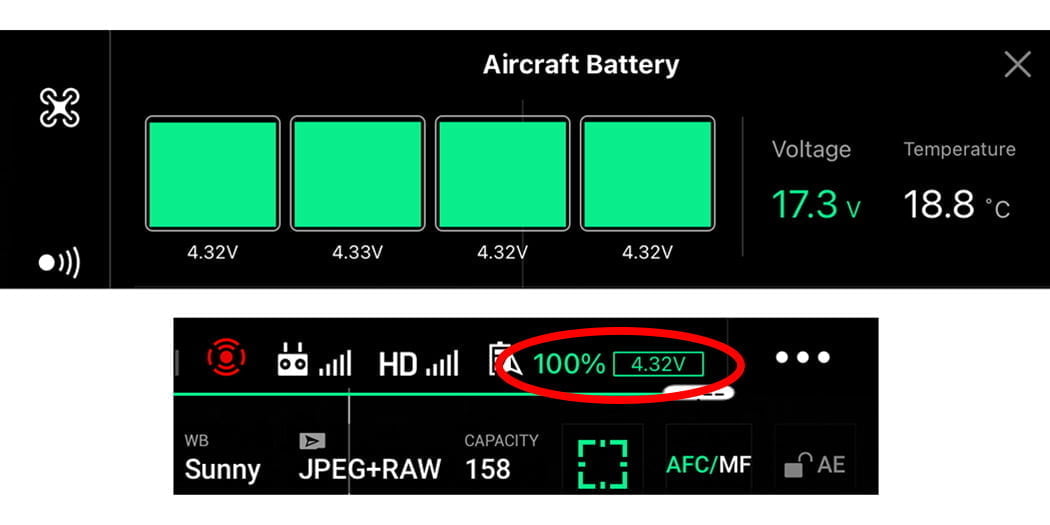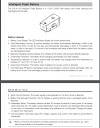You are using an out of date browser. It may not display this or other websites correctly.
You should upgrade or use an alternative browser.
You should upgrade or use an alternative browser.
Danger Using Batteries in 'Self Discharge State'
- Thread starter pnovotny
- Start date
Octavio
Well-Known Member
I really don't know what to say because personally, I didn't investigate battery performance, but I tend not to drain my batteries much. And also, I tend to remove them before the full charge even with all my other batteries.Hello Friends,
I came across this article which claims that it's dangerous to use drone batteries which are in 'Self Discharge State' (batteries which have begun discharging per DJI settings) and that you need to fully charge them prior to use (unless it's a continuation of a previous flight a short time ago, prior to self discharge).
Can anyone verify this?
If this is correct, if a battery was purposely discharged to 60%, can it be considered stable and therefore safe to use?
Thanks for your comments.
Attached is a link to the article, see part 4.

Proper Drone Battery Storage & Care to Maximize Life & Performance
Proper drone battery storage and care will maximize their life and performance. Here are some tips for charging and storing them.www.jmpeltier.com
My friend warned me about having to be careful to keep an eye on the battery levels because his drone just fell off from the sky suddenly after 5 or 10 minutes of flight.
and since that time, he doesn't want to talk about Drones anymore.
I have learned to never talk about Drones to him again.
Rchawks
Well-Known Member
peterc4
Well-Known Member
used mine many many times with no issues in several dji drones, used one today on my mav 3 no issues
waltermitty
Well-Known Member
I know that a battery may show a favorable X% battery condition leading one to think all is well and proceed to fly. Going back to my years of electronics and power source notes, a huge factor which may skew this % or seemingly healthy volts reading is the issue of battery internal resistance... which increases with age.
Does anyone know if anyone markets a test device which can easily and quickly calculate the internal resistance of an Autel battery (or any other, for that matter) ? I have test units which can measure zinc, nicad, niMH and lithium batteries (Ω) but nothing yet, for drone size batteries.
Does anyone know if anyone markets a test device which can easily and quickly calculate the internal resistance of an Autel battery (or any other, for that matter) ? I have test units which can measure zinc, nicad, niMH and lithium batteries (Ω) but nothing yet, for drone size batteries.
- Joined
- Oct 17, 2020
- Messages
- 1,215
- Reactions
- 897
- Age
- 44
- Location
- Grand Rapids, MI
- Site
- karlblessing.com
Don't know about getting that technical, but I know AirData will show the performance and draw of each cells and their deviations thru the whole flight log and give an estimate on battery health from that (As well as showing the batteries actual maximum capacity while DJI still shows it as 100%).I know that a battery may show a favorable X% battery condition leading one to think all is well and proceed to fly. Going back to my years of electronics and power source notes, a huge factor which may skew this % or seemingly healthy volts reading is the issue of battery internal resistance... which increases with age.
Does anyone know if anyone markets a test device which can easily and quickly calculate the internal resistance of an Autel battery (or any other, for that matter) ? I have test units which can measure zinc, nicad, niMH and lithium batteries (Ω) but nothing yet, for drone size batteries.
waltermitty
Well-Known Member
I could do it the old school way using Kirchhoff's law but it requires a bit more than counting with my fingers. I may give it a tray if it nags me enough

 www.omnicalculator.com
www.omnicalculator.com

Internal Resistance Calculator
Calculate the internal resistance of a battery using the internal resistance calculator.
Oman
Well-Known Member
AmenTRANSLATION: Charge your batteries to 100% before flight.
Bob in Savannah
Masters Patron
- Joined
- Aug 6, 2018
- Messages
- 1,056
- Reactions
- 1,950
- Age
- 58
- Location
- Savannah, GA. USA
- Site
- instagram.com
Yes, what Ive heard (and it seems to be true) is that the self-discharge works just like its stated BUT if you push the button on the battery to check its level (whether it's in the drone or not) the self-discharge "timer" will reset and start from scratch no matter where the battery level is. So, that means it wont start discharging again for another three days and start the whole process again.The batteries will start to discharge the moment you remove them from the charger I expect. However I read that if press the power button to confirm fully charged then this delays the auto discharge, can someone confirm.
But the other point is I always check the individual cell voltages before take off, make sure they are within .02% of each other.
Last edited:
4 inch pistons
Well-Known Member
Interesting reading here. My LiOn days when I flew RC Airplanes, we had "Battery Maintainers" that would charge, discharge, maintain, discharge, charge, etc....When you were ready to fly, unplug it and go.
JackWendel
Member
Would someone explain auto discharge to me (sorry still a newbie) is it bad and how do you know its happening. TIA
- Joined
- Oct 17, 2020
- Messages
- 1,215
- Reactions
- 897
- Age
- 44
- Location
- Grand Rapids, MI
- Site
- karlblessing.com
Because it says so in the manual, and evident when you pop a battery into your drone after not touching it for over 5~6 days and it's right at 60% (and almost always at 95~96% after 24 hours of not touching it).Would someone explain auto discharge to me (sorry still a newbie) is it bad and how do you know its happening. TIA
In the case of the Air 2S and many of DJI's recent drones, it details it in the manual, feature #2 and #10

Manual also includes instructions on how to care for and charge the battery. (as well as stating you should drain it below 30% before transportation , which I don't think anyone ever does).

Let's close the circle.
One more point:
I finish my flight. 25% battery. and ...
100 charge cycles.
Two options:
1º).- I recharge it at 100%. Self-discharge begins after 48 hours. reaching 60%.
I recharge it 100% on my next flight.
2º).- I recharge it in maintenance mode, at 60%.
I recharge it 100% on my next flight.
In which charging option, will it add one more charging cycle (it will have 101 cycles)? , or the same question in another way: Which of the two charging options will not add one more charging cycle.
Great question ( DJI has not answered me yet ) .
One more point:
I finish my flight. 25% battery. and ...
100 charge cycles.
Two options:
1º).- I recharge it at 100%. Self-discharge begins after 48 hours. reaching 60%.
I recharge it 100% on my next flight.
2º).- I recharge it in maintenance mode, at 60%.
I recharge it 100% on my next flight.
In which charging option, will it add one more charging cycle (it will have 101 cycles)? , or the same question in another way: Which of the two charging options will not add one more charging cycle.
Great question ( DJI has not answered me yet ) .
There's no point recharging to 100% unless you are going to be flying soon.Let's close the circle.
One more point:
I finish my flight. 25% battery. and ...
100 charge cycles.
Two options:
1º).- I recharge it at 100%. Self-discharge begins after 48 hours. reaching 60%.
I recharge it 100% on my next flight.
2º).- I recharge it in maintenance mode, at 60%.
I recharge it 100% on my next flight.
In which charging option, will it add one more charging cycle (it will have 101 cycles)? , or the same question in another way: Which of the two charging options will not add one more charging cycle.
Great question ( DJI has not answered me yet ) .
If not, charge to approx 50% and leave it that way.
That will add less charge cycles than charging to 100%.
This is exactly what I do normally. 50% is my number. On my RC Airplanes batteries on top of that, I put a blinky balancer for an hour to make sure all the cells are completely balanced. If I am not mistaking the DJI batteries has one built-in.There's no point recharging to 100% unless you are going to be flying soon.
If not, charge to approx 50% and leave it that way.
That will add less charge cycles than charging to 100%.
I own a iCHARGER 4010 DUO. Also, I used to monitor the internal resistant which is important.
minipro3
Well-Known Member
I second that, I really appreciate the patience of everyone here !!I always found the best way to avoid being irritated by the redundancy of a subject or post is to avoid the subject and move on the another post. We all wear the dunce cap at one time or another, the important thing is to help others when you can and take what they have to offer to you. There are some very, very smart people on this site and I'm sure most all this information is redundant to them. I'm always amazed at the information they pass to all of us and we'll **** lucky to have this site available to all of us.
Thank you for all the valuable info, there's soo much to learn for us newbie's
It pays to have extra batteries so you don’t have to keep pushing what you have to it’s limit.
I’m a 3 battery minimum for each of my drones even if they use the same battery ie M3 and E3 T.
minimum for each of my drones even if they use the same battery ie M3 and E3 T.
if you only have 2 and one goes bad it could be a very bad or long day. Extra batteries are an insurance policy that pays .
I’m a 3 battery
if you only have 2 and one goes bad it could be a very bad or long day. Extra batteries are an insurance policy that pays .
The short answer is no, any battery at 60%, regardless of whether it's self discharged or flown down to that level should never be used for a fresh new flight.Hello Friends,
I came across this article which claims that it's dangerous to use drone batteries which are in 'Self Discharge State' (batteries which have begun discharging per DJI settings) and that you need to fully charge them prior to use (unless it's a continuation of a previous flight a short time ago, prior to self discharge).
Can anyone verify this?
If this is correct, if a battery was purposely discharged to 60%, can it be considered stable and therefore safe to use?
Thanks for your comments.
Attached is a link to the article, see part 4.

Proper Drone Battery Storage & Care to Maximize Life & Performance
Proper drone battery storage and care will maximize their life and performance. Here are some tips for charging and storing them.www.jmpeltier.com
As been said, if you start with a freshly charged battery at 100% and land at 60% its safe to take off again right away and continue flying, but starting with a battery thats been idle for days at 60% is asking for trouble.
As far as the self discharge function goes, it varies from model to model. On the Phantom 3 series you have more control and can set the number of days from 1 to 10 to start self discharging, plus the Go app actually tells you the state of the battery, self discharging in storage, broken cell, or OK. The Mavic 3 gives less info and doesn't allow changing the number of days before self discharge. My practice has always been, If I land with less than 50% battery, I let it cool then fully charge before storing. If I land at above 50% I just store it as is. And in every case I fully charge just before flying.
- Joined
- May 25, 2017
- Messages
- 8,476
- Reactions
- 7,966
- Age
- 63
As been said, if you start with a freshly charged battery at 100% and land at 60% its safe to take off again right away and continue flying, but starting with a battery thats been idle for days at 60% is asking for trouble.
Agree in principle, but it is ok to fly say later in the day with a battery earlier flown down to your 60% example, or even 40% or 30%.
I've done that a few times when I only had the 3 flymore batteries for my M1P.
But only for literally that one photo or video you can see begging to be had . . . up, photo / video, down.
No risk there.
But yes, idle for days, even if self discharge set for a longer period, there's no need to risk that, just charge up whatever is required for use.
I have 6 perfect batteries for mine for a couple of years now, and hardly ever find I need them all on a trip, especially when combined with the Spark and 5 batteries for that too.
Agreed on all points, including flying the same battery on the same day without recharging. Use common sense and know your equipment. It takes time and use to fully trust it. Once you know that you are safe.Agree in principle, but it is ok to fly say later in the day with a battery earlier flown down to your 60% example, or even 40% or 30%.
I've done that a few times when I only had the 3 flymore batteries for my M1P.
But only for literally that one photo or video you can see begging to be had . . . up, photo / video, down.
No risk there.
But yes, idle for days, even if self discharge set for a longer period, there's no need to risk that, just charge up whatever is required for use.
I have 6 perfect batteries for mine for a couple of years now, and hardly ever find I need them all on a trip, especially when combined with the Spark and 5 batteries for that too.
Similar threads
- Replies
- 8
- Views
- 1K
- Replies
- 9
- Views
- 1K
- Replies
- 7
- Views
- 2K
DJI Drone Deals
New Threads
-
-
-
-
Selling Mini 4 Pro Fly More Combo, RC2 controller, 3 batteries, 8 ND Filters
- Started by Dale D
- Replies: 0
-










